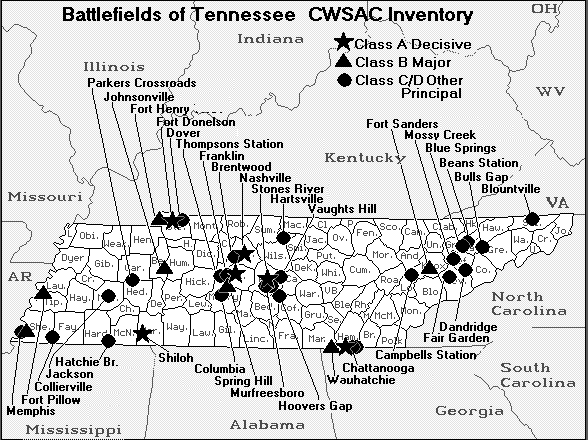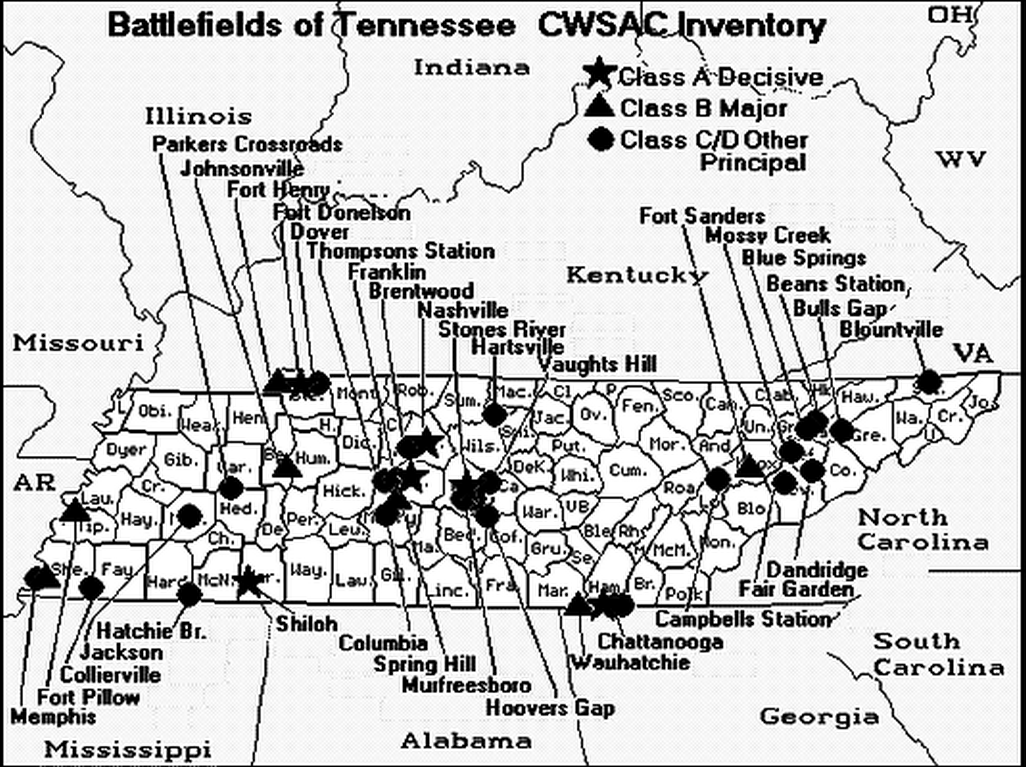|
Battle of Chattanooga History
Battle of Chattanooga
Other Names: First Battle of Chattanooga
Location: Hamilton County and City of Chattanooga
Campaign: Confederate Heartland Offensive (1862)
Date(s): June 7-8, 1862
Principal Commanders: Brig. Gen. James Negley [US]; Maj. Gen.
Edmund Kirby Smith [CS]
Forces Engaged: Division [US]; Department [CS]
Estimated Casualties: 88 total (US 23; CS 65)
| Battle of Chattanooga |

|
| Civil War Battle of Chattanooga Tennessee Map |
Description: In late Spring 1862, the Confederacy split its forces
in Tennessee into several small commands in an attempt to complicate Federal operations. The Union had to redistribute its
forces to counter the Confederate command structure changes. Maj. Gen. Ormbsy Mitchel (died of Yellow Fever on October 30,
1862) received orders to go to Huntsville, Alabama, with his division to repair railroads in the area. Soon, he occupied more
than 100 miles along the Nashville & Chattanooga and Memphis & Charleston railroads. In May, Mitchel and his men sparred
with Maj. Gen. Edmund Kirby Smith's men. After Mitchel received command of all Federal troops between Nashville and Huntsville,
on May 29, he ordered Brig. Gen. James Negley with a small division to lead an expedition to capture Chattanooga. This
force arrived before Chattanooga on June 7. Negley ordered the 79th Pennsylvania Volunteers out to reconnoiter. It found the
Confederates entrenched on the opposite side of the river along the banks and atop Cameron Hill. Negley brought up two artillery
batteries to open fire on the Rebel troops and the town and sent infantry to the river bank to act as sharpshooters. The Union
bombardment of Chattanooga continued throughout the 7th and until noon on the 8th. The Confederates replied, but it was uncoordinated
since the undisciplined gunners were allowed to do as they wished. On June 10, Smith, who had arrived on the 8th, reported
that Negley had withdrawn and the Confederate loss was minor. This attack on Chattanooga was, however, a warning that Union troops could mount assaults
when they wanted. The Confederate Heartland Offensive included the following battles: Chattanooga, Murfreesboro,
Richmond (Kentucky), Munfordville and Perryville. The "Campaign," from an attrition standpoint, proved to be a Union disaster. Union casualties totaled more than
14,000, while Confederate casualties numbered less than 5,000.
| Chattanooga Battlefield Map |

|
| Battle of Chattanooga Map |
Analysis: The first part of the Battle of Chattanooga was
a minor battle occurring from June 7 to June 8, 1862. In late spring 1862, the Confederacy split its forces in Tennessee into
several small commands in an attempt to complicate Federal operations. The Union army had to redistribute its forces to counter
the Confederate command structure changes. Major General Ormsby M. Mitchel received orders to take his division to Huntsville,
Alabama, to repair railroads in the area. Soon, he occupied more than one hundred miles along the Nashville & Chattanooga
and Memphis and Charleston railroads. In May, Mitchel and his men fought with Major General Edmund Kirby Smith’s men.
After Mitchel received command of all Federal troops between Nashville
and Huntsville, on May 29, he ordered brigadier general James Negley with a small division to lead an expedition to capture
Chattanooga. This force arrived before Chattanooga on June 7. Negley ordered the 79th Pennsylvania Volunteers out to reconnoiter.
It found the Confederates entrenched on the opposite side of the river along the banks and atop Cameron Hill. Negley brought
up two artillery batteries to open fire on the Confederate troops and the town and sent infantry to the river bank to act
as sharpshooters. The Union bombardment of Chattanooga continued throughout the 7th and until noon on the 8th. The Confederates
retaliated, but it was uncoordinated and sloppy. On June 10, Smith, who had arrived on the 8th, reported that Negley had withdrawn
and the Confederate loss was minor. This attack on Chattanooga was a warning that Union troops could mount assaults at will.
(Related reading and sources are listed below.)
Recommended Reading: The Shipwreck of Their
Hopes: THE BATTLES FOR CHATTANOOGA (Civil War Trilogy) (536 pages) (University
of Illinois Press). Review (Booklist): Cozzens delivers another authoritative
study with the Chattanooga campaign. Braxton Bragg (who
sometimes seems unfit to have been at large on the public streets, let alone commanding armies) failed to either destroy or
starve out the Union Army of the Cumberland. In due course,
superior Northern resources and strategy--not tactics; few generals on either side come out looking like good tacticians--progressively
loosened the Confederate cordon around the city. Continued below...
Finally, the Union drove off Bragg's army entirely in the famous Battle of Missionary Ridge, which was a much more
complex affair than previous, heroic accounts make it. Like its predecessor on Chickamauga, this is such a good book on Chattanooga
that it's hard to believe any Civil War collection will need another book on the subject for at least a generation. Roland
Green
Advance to:
Recommended
Reading: Six Armies in Tennessee:
The Chickamauga and Chattanooga
Campaigns (Great Campaigns of the Civil War). Description: When Vicksburg fell to Union forces under General Grant in July 1863, the balance turned against
the Confederacy in the trans-Appalachian theater. The Federal success along the river opened the way for advances into central
and eastern Tennessee, which culminated in the bloody battle of Chickamauga
and then a struggle for Chattanooga. Chickamauga is usually counted as a Confederate victory, albeit a costly one. Continued below...
That battle—indeed the entire campaign—is marked by muddle and blunders occasionally relieved
by strokes of brilliant generalship and high courage. The campaign ended significant Confederate presence in Tennessee and left the Union
poised to advance upon Atlanta and the Confederacy on the
brink of defeat in the western theater.
Recommended Reading: Lee
at Chattanooga: A Novel of What Might Have Been. Description: Many intriguing variables are entertained in this thought-provoking answer to the question.
These include such observations that Lee would have faced Grant six months sooner than he did. Possibly Lee’s mission
could have paralleled his earlier campaign in western Virginia. Bragg might have resented Lee’s presence and relied
on his close ties to Davis to limit Lee’s influence. Dennis McIntire has done an outstanding job of researching
the possibilities and his thought-provoking insight makes this a must have… (Continued below)
One of the “Great What-Ifs” of the Civil War!
Of all the Confederate generals of the American Civil War, none is as revered as Robert E. Lee or as despised as Braxton Bragg.
While Lee was invaluable to Jefferson Davis, Bragg was a longtime friend of the president and had his unwavering support.
Bragg was in a precarious position at Chattanooga in August 1863. The Union Army of the Cumberland, which had swept him out
of Middle Tennessee only a month earlier, was poised before him again. With his depleted ranks of barely thirty thousand men,
Bragg faced fifty thousand Federals. When he finally called for reinforcements, Richmond responded with a pledge of twenty
thousand men. They were to come from Joseph E. Johnston’s army in Mississippi and Lee’s Army of Northern Virginia.
Lee dispatched James Longstreet’s corps, totaling some twelve thousand men. It was also rumored at the time that Davis
pondered sending Lee. That is the possibility explored in Lee at Chattanooga. What might have happened if Lee had been sent
to Chattanooga in September 1863?
Editor's
Choice: CIVIL
WAR IN WEST SLIP CASES: From Stones River to Chattanooga
[BOX SET], by Peter Cozzens (1528 pages) (University of Illinois Press). Description:
This trilogy very competently fills in much needed analysis and detail on the critical Civil War battles of Stones River, Chickamauga
and Chattanooga. "Cozzens'
comprehensive study of these three great battles has set a new standard in Civil War studies....the research, detail and accuracy
are first-rate." Mr. Cozzens' has delivered
a very valuable, enjoyable work deserving of attention. The art work by Keith Rocco is also a nice touch, effecting, without
sentimentality...historical art which contributes to the whole.
Recommended Reading: Chattanooga: A Death Grip on the Confederacy.
Description: Perhaps McDonough's finest civil war study, Chattanooga
is not only highly readable and dramatic, but an excellent revisionist history. It lays to rest major old chestnuts over 125
years old at the time of publication, most importantly the nature of and reasons for the charge on Missionary
Ridge. Continued below…
Written essentially from the middle
command perspective, the grasp of tactics, deployments, and all things military is faultless. McDonough, however, did not
stop with battle reports and other prior published studies, but got out and walked the battlefield to understand precisely
what happened. He thus was able to uncover facts long obscured both by the smoke of battle and the subsequent ongoing war
of words. There is also much original research here from never published diaries only available in state and local historical
collections, casting further light. Nor does McDonough spoil his product by sensationalist claims of old versus new conclusions;
he unassumingly blends all available sources into a new synthesis. With apparent focus on the battle from human witnesses,
readability and drama are increased -- but never so far as to make the book merely anecdotal. Further, the error of many classical
studies merely concentrating on the highest command is abolished, without verging into the like trap of seeing it all from
the level of "citizen soldier," etc. McDonough simply has no apparent axe to grind whatsoever. The footnotes and sources are
full and clear, the maps ample and readable. All in all, this is state of the art Civil War history at its best, setting a
new standard in the genre for both the general and specialized reader.
Recommended Viewing: The Civil War - A Film by Ken Burns. Review: The
Civil War - A Film by Ken Burns is the most successful public-television miniseries in American history. The 11-hour Civil War didn't just captivate a nation,
reteaching to us our history in narrative terms; it actually also invented a new film language taken from its creator. When
people describe documentaries using the "Ken Burns approach," its style is understood: voice-over narrators reading letters
and documents dramatically and stating the writer's name at their conclusion, fresh live footage of places juxtaposed with
still images (photographs, paintings, maps, prints), anecdotal interviews, and romantic musical scores taken from the era
he depicts. Continued below...
The Civil War uses all of these devices to evoke atmosphere and resurrect an event that many knew
only from stale history books. While Burns is a historian, a researcher, and a documentarian, he's above all a gifted storyteller,
and it's his narrative powers that give this chronicle its beauty, overwhelming emotion, and devastating horror. Using the
words of old letters, eloquently read by a variety of celebrities, the stories of historians like Shelby Foote and rare, stained
photos, Burns allows us not only to relearn and finally understand our history, but also to feel and experience it. "Hailed
as a film masterpiece and landmark in historical storytelling." "[S]hould be a requirement for every
student."
Sources: National Park Service; Official Records of the Union and Confederate
Armies; Catton, Bruce. The American Heritage Picture History of the Civil War. New York Bonanza Books, 1982, 1960. ISBN 0517385562;
Eicher, David J. The Longest Night: A Military History of the Civil War. New York Simon & Schuster, 2001. ISBN 0684849445;
McDonough, James Lee. Chattanooga: A Death Grip on the Confederacy. Knoxville, Tennessee The University of Tennessee Press,
1984. ISBN 0870494252.
Try the Search Engine for Related Studies: Battle of Chattanooga Tennessee History, Tennessee
Civil War History, List of Tennessee Civil War Battles Details Summary Facts Results Map, East Tennessee Mountains Civil War
Army Picture Photograph
|

